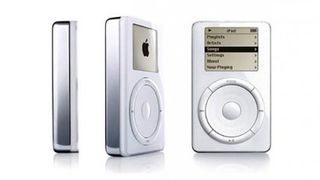iNspired: the origin stories of some of our favorite gadgets
Did you know the Wii once had a touchscreen?

So many new gadgets fall into our laps every day that it's easy to think they just appear in the world, fully-formed like a baby elephant. But every device ever sold - whether it was an epic failure or a huge success - was the result of an idea, a cauldron of inspirations, and a heck of a lot of work. Like the heroes and villains in superhero movies, every gadget has an origin story, and we think they should be told.
Here, we've taken a look at the inspiration behind the four major gadgets that once went by the codenames Revolution, Oculus Thrift, Ginger and Dulcimer - and the sometimes strange circumstances that led to their final form.
Nintendo Wii
Once had a touchscreen

Remember when Nintendo announced that the awesomely-codenamed Revolution would actually be called the a-name-so-bad-it's-almost-good Wii? The "I need a Wii" jokes somewhat masked the fact that Nintendo had brilliantly zig-zagged in its efforts to beat the competing Xbox 360 and PlayStation 3.
While the Wii wasn't released until 2006, a detailed interview with Nintendo's legendary Shigeru Miyamoto reveals it was conceived all the way back in 2001 - just as its predecessor the GameCube went on sale.
Miyamoto and his colleague Ken'ichiro Ashida recall that they thought about a very specific audience as they developed the Wii - but not the one you might imagine. Instead of making high-powered consoles like Microsoft and Sony, they designed with mums in mind.
"We thought a low-cost console would make mums happy," explains Miyamoto, so they aimed to come in at under $211 (about £154, AU$282). Building a power-hungry console for that price would hike up electricity bills and need noisy fan cooling, which Nintendo thought mums would hate, so they went for the crowd-pleasing budget design that eventually became the Wii.
You can thank your mum for its backwards compatibility with the GameCube, too: Team Nintendo thought she'd be happier without multiple machines and wires littering up the place.
Get daily insight, inspiration and deals in your inbox
Get the hottest deals available in your inbox plus news, reviews, opinion, analysis and more from the TechRadar team.
The Wii's five years of development were well-used - the console went through several iterations, including one with a touchscreen inspired by the Nintendo DS. Its game-changing controller didn't instantly appear fully-formed, either: prototypes included something like a mobile phone, and one that had "an analogue stick on top and digital interface on bottom" - sound familiar, Wii U fans?
Google Cardboard
Grew out of a rule that "no longer exists"

Just about everyone's heard of Google's much-lauded 20% policy: that all employees can use 20% of their working time to work on something that "they think will most benefit Google."
However, in recent years, the policy's been declared "as good as dead," as it emerged that extracurricular projects are undertaken on top of Google engineers' workload and can harm performance reviews. As Ex-Googler Marissa Meyer put it, it's "really 120% time."
Given how stacked Google engineers already are, it's amazing that any of them have pursued 20% projects at all, but as well as Gmail and Google Now, one of the projects that sprang out of 20% time is Google Cardboard in 2014.
Launched at the I/O conference that year, Google's virtual reality headset is made quite literally out of cardboard and uses your smartphone as the screen. It was prototyped by David Coz and Damien Henry from the Cultural Institute in Paris, Google's collaborative creator space that famously made thousands of pieces of art available for viewing online. Coz had ambitions to leave Paris and join the main Google HQ in Mountain View, but to do that, he needed to get the right attention - and Cardboard provided a way.
The idea came about when Coz and Henry wanted to view a 3D video of drone footage on YouTube, but didn't have a VR headset. They realised they could use a phone screen and some scaffolding, as long as "the phone understands where your head is looking," says Coz.
They chose cardboard to make the headset because it was easy to work with, and made the first batch with a laser cutter. The pair showed their creation to their colleagues, and spurred by their enthusiasm, Coz took it with him to Google HQ.
There, he met physical interaction researcher Christian Plagemann, whose team helped turn it into the well-loved 'Oculus Thrift' that's sold over 5 million units to date. Just two months after Coz returned to Paris, Cardboard was officially launched by Google CEO Sundar Pichai at I/O, and was so popular that they ran out of headsets to give attendees. As for Coz and Henry, they both still work for Google - Henry in Paris, and Coz at his dream job in the VR team at Mountain View and Cardboard has morphed into Daydream, a more mature platform that all the big brands are getting behind.
The Segway
Inspired by a wheelchair

Predecessor to the current vexing crop of so-called hoverboards, the Segway has long been the punchline of personal transportation.
It hit the news in 2001, when a book about it leaked to the internet before the product had even been unveiled. That tome containined an apparent quote from Steve Jobs claiming it was "as big a deal as the PC."
At this point, no one knew what the product actually was, so the rumor mills were on fire. When it transpired it was a weird, two-wheeled over-engineered skateboard, the scorn was instantaneous - there was even a South Park episode in its 'honor'.
But the Segway was actually a brilliant piece of engineering. Developed using insights from inventor Dean Kamen's previous creation the iBot - essentially the 4x4 of wheelchairs - the Segway's movement system was based on humans' instinctive sense of balance.
That meant you could roll forwards and back, and stop with tiny movements - almost just by thinking about it. Used properly, it was actually quite graceful, and therefore worthy of its initial codename Ginger, after Ginger Rogers.
The name was the counterpart to the iBot's nickname "Fred Upstairs" (Astaire) since it could climb staircases. Ginger, frankly, was a better name than Segway - a phonetic reinterpretation of "segue," meaning a smooth transition.
Sometimes that transition was a little too smooth, though - the Segway had no brakes. When British businessman James Heselden bought the Segway company in 2009, that fact proved fatal: he accidentally rode one off a cliff and fell 30 feet to his death.
The iPod
References Stanley Kubrick

Everyone knows the name 'iPod'. It's so ubiquitous that people started using it for every MP3 player, back when MP3 players were a thing - as one ex-colleague demonstrated when he showed me his new "Samsung iPod." It even lent its name to podcasts, which have long since grown independent of Apple's wheeled little music player. But why "pod"?
Brilliantly, the name was inspired by 2001: A Space Odyssey - specifically the famous "open the pod bay doors, HAL" line. While Steve Jobs coined the slogan "1000 songs in your pocket" for the product codenamed Dulcimer, the final name was devised by a freelancer.
San Francisco-based writer Vinnie Chieco suggested 'pod' because the player connected to the Mac like a pod to a spaceship, and the bright, shiny white prototype reminded him of 2001.
The fact that early iPods often refused to co-operate with your wishes was just a lucky coincidence...
The iPod is considered one of Apple's signature products, an invention that sparked a revolution. But alongside Apple's undoubted triumph of design and innovation was another tech behemoth: Toshiba.
Engineering lead Jon Rubinstein spotted their 1.8-inch hard drive at a meeting with a supplier in Japan, and while Toshiba apparently had no idea what to do with it, Rubinstein immediately told Steve Jobs "Hey, I'm gonna need about 10 million bucks" to buy them all.
That hard drive, considered tiny at the time, enabled the sleek, sophisticated design we now remember as the first of many iPods - released in, of course, 2001.
